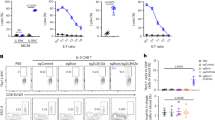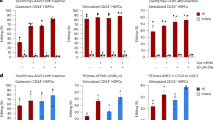Abstract
To optimize a gene transfer system for hematopoietic stem cell gene therapy of patients with mucopolysaccharidosis (MPS) type I, 10 retroviral vectors were constructed to express the human α-L-iduronidase (IDUA) cDNA. These vectors were designed to evaluate the potential effects of specific promoters, the addition of selectable markers, and the use of multiple promoters versus an internal ribosome entry site for expression of IDUA and selectable maker genes. The effect of vector design was investigated in primary patient fibroblasts (FMPS) or murine fibroblast cell lines; while overall comparison of transgene expression was determined in patients’ peripheral blood lymphocytes (PBLMPS) and CD34+ progenitors (PBPCMPS). We observed that the human PGK promoter introduced the highest IDUA activity per 1% relative transgene frequency in FMPS. Use of the same promoter to separately regulate both the therapeutic gene and a drug-resistance gene resulted in decreased expression of the unselected gene. Co-selection using bicistronic vectors not only increased the number of transductants, but also elevated transgene expression under selective pressure in transgene-positive progenitors. Bicistronic vector LP1CD overcame down-regulation and practically introduced the highest IDUA level in unselected PBLMPS and an intermediate level in PBPCMPS. These studies provide a better understanding of factors contributing to efficient gene expression in hematopoietic cells.
This is a preview of subscription content, access via your institution
Access options
Subscribe to this journal
Receive 12 print issues and online access
$259.00 per year
only $21.58 per issue
Buy this article
- Purchase on Springer Link
- Instant access to full article PDF
Prices may be subject to local taxes which are calculated during checkout




Similar content being viewed by others
References
Friedmann T . Human gene therapy – an immature genie, but certainly out of the bottle Nature Med 1996 2: 144–147
Leiden JM . Gene therapy – promise, pitfalls and prognosis New Engl J Med 1995 333: 871–873
Culver KW . Measuring success in clinical gene therapy research Mol Med Today 1996 2: 234–236
Rettinger SD et al. Liver-directed gene therapy: quantitative evaluation of promoter elements by using in vivo retroviral transduction Proc Natl Acad Sci USA 1994 91: 1460–1464
Scharfmann R, Axelrod JH, Verma IM . Long-term in vivo expression of retrovirus-mediated gene transfer in mouse fibroblast implants Proc Natl Acad Sci USA 1991 88: 4626–4630
Challita PM et al. Multiple modifications in cis elements of the long terminal repeat of retroviral vectors lead to increased expression and decreased DNA methylation in embryonic carcinoma cells J Virol 1995 69: 748–755
Palmer TD, Rosman GJ, Osborne WR, Miller AD . Genetically modified skin fibroblasts persist long after transplantation but gradually inactivate introduced genes Proc Natl Acad Sci USA 1991 88: 1330–1334
Challita PM, Kohn DB . Lack of expression from a retroviral vector after transduction of murine hematopoietic stem cells is associated with methylation in vivo Proc Natl Acad Sci USA 1994 91: 2567–2571
Lu M et al. High efficiency retroviral-mediated gene transduction into CD34+ cells purified from peripheral blood of breast cancer patients primed with chemotherapy and granulocyte–macrophage colony-stimulating factor Hum Gene Ther 1994 5: 203–208
Laker C et al. Host cis-mediated extinction of a retrovirus permissive for expression in embryonal stem cells during differentiation J Virol 1998 72: 339–348
Richards CA, Huber BE . Generation of a transgenic model for retrovirus-mediated gene therapy for hepatocellular carcinoma is thwarted by the lack of transgene expression Hum Gene Ther 1993 4: 143–150
Doerfler W et al. Integration of foreign DNA and its consequences in mammalian systems Trends Biotechnol 1997 15: 297–301
Qin L et al. Promoter attenuation in gene therapy: interferon-gamma and tumor necrosis factor-alpha inhibit transgene expression Hum Gene Ther 1997 8: 2019–2029
Kaleko M, Garcia JV, Osborne WR, Miller AD . Expression of human adenosine deaminase in mice after transplanation of genetically-modified bone marrow Blood 1990 75: 1733–1741
Moore KA et al. Human adenosine deaminase expression in mice Blood 1990 75: 2085–2092
Li M et al. Comparison of the expression of a mutant dihydrofolate reductase under control of different internal promoters in retroviral vectors Hum Gene Ther 1992 3: 381–390
Lim B, Williams DA, Orkin SH . Retrovirus-mediated gene transfer of human adenosine deaminase: expression of functional enzyme in murine hematopoietic stem cells in vivo Mol Cell Biol 1987 7: 3459–3465
Farina SF et al. Dysregulated expression of GATA-1 following retrovirus-mediated gene transfer into murine hematopoietic stem cells increases erythropoiesis Blood 1995 86: 4124–4133
Belmont JW et al. Expression of human adenosine deaminase in murine hematopoietic cells Mol Cell Biol 1988 8: 5116–5125
Bowtell DD, Cory S, Johnson GR, Gonda TJ . Comparison of expression in hemopoietic cells by retroviral vectors carrying two genes J Virol 1988 62: 2464–2473
Dumenco LL et al. Increase in nitrosourea resistance in mammalian cells by retrovirally mediated gene transfer of bacterial O6-alkylguanine-DNA alkyltransferase Cancer Res 1989 49: 6044–6051
Corey CA, DeSilva AD, Holland CA, Williams DA . Serial transplantation of methotrexate-resistant bone marrow: protection of murine recipients from drug toxicity by progeny of transduced stem cells Blood 1990 75: 337–343
Williams DA . Expression of introduced genetic sequences in hematopoietic cells following retroviral-mediated gene transfer Hum Gene Ther 1990 1: 229–239
Licht T, Herrmann F, Gottesman MM, Pastan I . In vivo drug-selectable genes: a new concept in gene therapy Stem Cells 1997 15: 104–111
Shull R et al. Humoral immune response limits gene therapy in canine MPS I Blood 1996 88: 377–379
Chu E, Grem JL, Johnston PG, Allegra CJ . New concepts for the development and use of antifolates Stem Cells 1996 14: 41–46
Moder KG et al. Hematologic malignancies and the use of methotrexate in rheumatoid arthritis: a retrospective study Am J Med 1995 99: 276–281
Emerman M, Temin HM . Quantitative analysis of gene suppression in integrated retrovirus vectors Mol Cell Biol 1986 6: 792–800
Kim DG, Kang HM, Jang SK, Shin HS . Construction of a bifunctional mRNA in the mouse by using the internal ribosomal entry site of the encephalomyocarditis virus Mol Cell Biol 1992 12: 3636–3643
Dirks W, Wirth M, Hauser H . Dicistronic transcription units for gene expression in mammalian cells Gene 1993 128: 247–249
Morgan RA et al. Retroviral vectors containing putative internal ribosome entry sites: development of a polycistronic gene transfer system and applications to human gene therapy Nucleic Acids Res 1992 20: 1293–1299
Hsieh CL et al. Improved gene expression by a modified bicistronic retroviral vector Biochem Biophys Res Commun 1995 214: 910–917
Sugimoto Y, Aksentijevich I, Gottesman MM, Pastan I . Efficient expression of drug-selectable genes in retroviral vectors under control of an internal ribosome entry site Biotechnology (N Y) 1994 12: 694–698
Pan D et al. ‘Supercharged cells’ for delivery of recombinant human iduronate-2-sulfatase Mol Genet Metab 2000 70: 170–178
Snyder EY, Senut MC . The use of nonneuronal cells for gene delivery Neurobiol Dis 1997 4: 69–102
Grande A et al. Transcriptional targeting of retroviral vectors to the erythroblastic progeny of transduced hematopietic stem cells Blood 1999 93: 3276–3285
Maze R et al. Reversal of 1,3-bis(2-chloroethyl)-1-nitrosourea-induced severe immunodeficiency by transduction of murine long-lived hemopoietic progenitor cells using O6-methylguanine DNA methyltransferase complementary DNA J Immunol 1997 158: 1006–1013
Delviks KA, Hu WS, Pathak VK . Psi-vectors: murine leukemia virus-based self-inactivating and self-activating retroviral vectors J Virol 1997 71: 6218–6224
Temin HM . Retrovirus variation and reverse transcription: abnormal strand transfers result in retrovirus genetic variation Proc Natl Acad Sci USA 1993 90: 6900–6903
Karlsson S . Gene therapy of haematopoietic cells J Internal Med 1997 740: (Suppl.) 95–99
McIvor RS . Drug-resistant dihydrofolate reductases: generation, expression and therapeutic application Bone Marrow Transplant 1996 18: S50–S54
Williams DA, Hsieh K, DeSilva A, Mulligan RC . Protection of bone marrow transplant recipients from lethal doses of methotrexate by the generation of methotrexate-resistant bone marrow J Exp Med 1987 166: 210–218
Blau CA, Neff T, Papayannopoulou T . The hematological effects of folate analogs: implications for using the dihydrofolate reductase gene for in vivo selection Gene Therapy 1996 7: 2069–2078
May C, Gunther R, Mclvor RS . Protection of mice from lethal doses of methotrexate by transplantation with transgenic marrow expressing drug-resistant dihydrofolate reductase activity Blood 1995 86: 2439–2448
Allay JA et al. In vivo selection of retrovirally transduced hematopoietic stem cells Nature Med 1998 4: 1136–1143
Challita PM et al. Multiple modifications in cis elements of the long terminal repeat of retroviral vectors lead to increased expression and decreased DNA methylation in embryonic carcinoma cells J Virol 1995 69: 748–755
Yaron Y, Kramer RL, Johnson MP, Evans M . Gene therapy Is the future here yet? Obs Gyn Clin N Am 1997 24: 179–199
Miller AD, Rosman GJ . Improved retroviral vectors for gene transfer and expression Biotechniques 1989 7: 980–982
Markowitz D, Goff S, Bank A . A safe packaging line for gene transfer: separating viral genes on two different plasmids J Virol 1988 62: 1120–1124
Morris JA, Mclvor RS . Saturation mutagenesis at dihydrofolate reductase codons 22 and 31; a variety of amino acid substitutions conferring methotrexate-resistance Biochem Pharmacol 1994 47: 1207–1220
Miller AD, Buttimore C . Redesign of retrovirus packaging cell lines to avoid recombination leading to helper virus production Mol Cell Biol 1986 6: 2895–2902
Higuchi R . Simple and rapid preparation of samples for PCR. In: Erlich HA (ed) PCR Technology Stockton Press: London 1989 pp 30–38
Whitley CB, Gorlin RJ, Krivit W . A nonpathologic allele (IW) for low alpha-L-iduronidase enzyme activity vis-à-vis prenatal diagnosis of Hurler syndrome Am J Med Genet 1987 28: 233–243
Bradford MM . A rapid and sensitive method for the quantitation of microgram quantities of protein utilizing the principle of protein-dye binding Anal Biochem 1976 72: 248–254
Pan D . Preclincial studies of hematopoietic cell gene therapy for patients with mucopolysaccharidosis type I and type II by retroviral vectors Doctoral thesis, University of Minnesota, Minneapolis 1997
Acknowledgements
This work was supported by a grant from the National Institute of Child Health and Human Development (PO1-HD32652).
Author information
Authors and Affiliations
Rights and permissions
About this article
Cite this article
Pan, D., Aronovich, E., McIvor, R. et al. Retroviral vector design studies toward hematopoietic stem cell gene therapy for mucopolysaccharidosis type I. Gene Ther 7, 1875–1883 (2000). https://doi.org/10.1038/sj.gt.3301298
Received:
Accepted:
Published:
Issue Date:
DOI: https://doi.org/10.1038/sj.gt.3301298
Keywords
This article is cited by
-
Normalization and Improvement of CNS Deficits in Mice With Hurler Syndrome After Long-term Peripheral Delivery of BBB-targeted Iduronidase
Molecular Therapy (2014)
-
Treatment of adult MPSI mouse brains with IDUA-expressing mesenchymal stem cells decreases GAG deposition and improves exploratory behavior
Genetic Vaccines and Therapy (2012)



